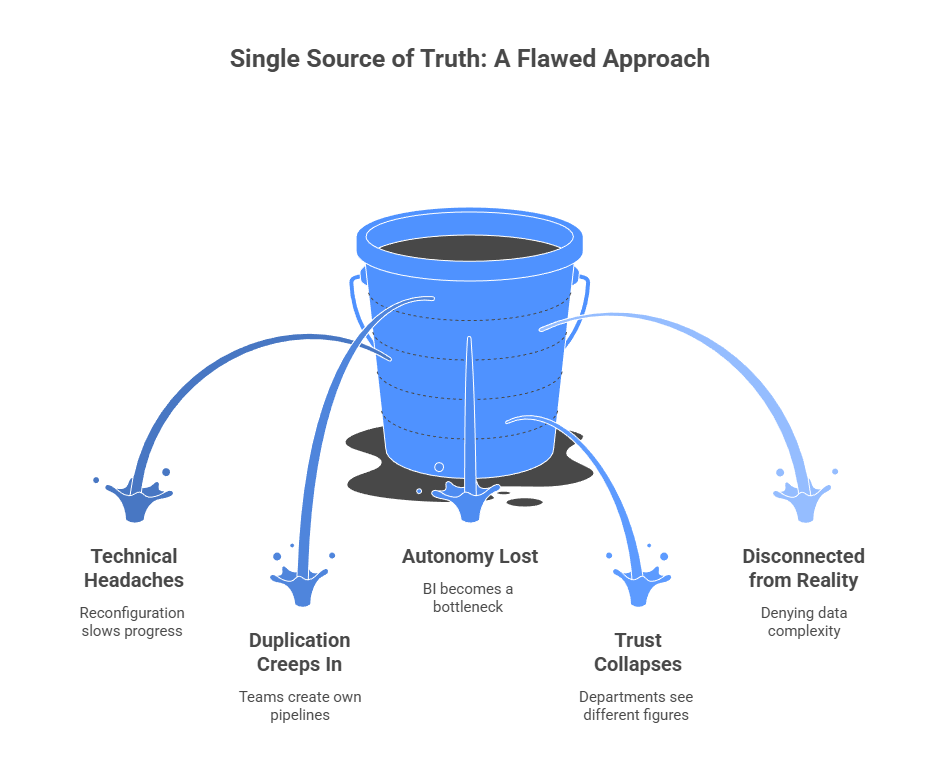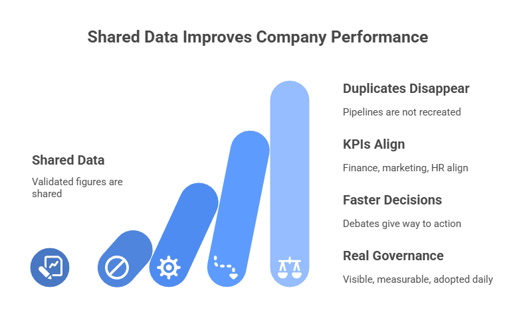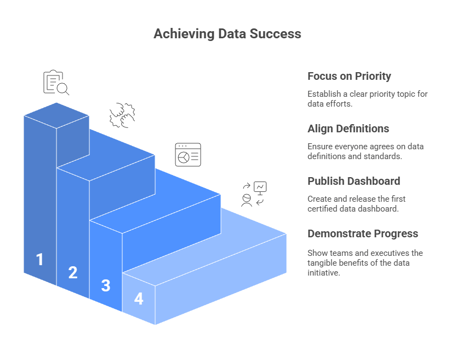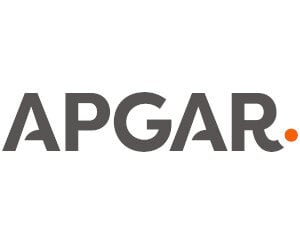Single Source of Truth: How to Finally Make It Work with Collaborative Spaces
Single Source of Truth: why you'll never get it right... and how to (really) succeed with collaborative spaces
For the past two decades, Single Source of Truth (SSOT) has been one of the grails of data management. The idea is seductive: to have a single, validated version of the reference data, shared by all business and IT teams. In other words, when two people open a report or a dashboard, they see the same figures, because they come from the same governed source.
On paper, this is ideal: less confusion, fewer sterile debates, faster decisions.
But in reality, very few organizations succeed. Why is this? Because their systems are extremely complex: according to an IDG-Matillion study, companies operate an average of almost 400 data sources, and over 20% manage more than 1,000. Add to this the explosion of tools: Forrester estimates that a large organization today uses around 367 different applications. In such an environment, "competing truths" multiply mechanically.
And the cost is high. Gartner has put the cost of poor data quality at an average of $15 million a year for a company. Some companies, such as Unity in 2023, have even publicly declared massive losses linked to data errors in their financial reports. The quest for a "single truth" is therefore not a technical whim: it's a question of economic survival.
1) Why the "one system" myth always fails
The most frequent confusion surrounding the Single Source of Truth stems from a simple idea... but a false one: the belief that a single truth must necessarily be based on a single centralized system.
In theory, this seems logical: if all data is gathered in a single warehouse or Master Data Management tool, then everyone should finally be seeing the same figures.
In reality, the exact opposite is true.

- Every business change becomes a technical headache, as everything has to be reconfigured in the central system.
- To go faster, teams recreate their own definitions or pipelines... and duplication goes out the window.
- Businesses lose their autonomy, and BI becomes a bottleneck.
- And above all, trust breaks down: two departments open a dashboard that's supposed to be common, and discover... two different figures.
Feedback from the field is irrefutable: "single truth" projects built like centralized fortresses fail. Not because the tools are wrong, but because the approach is disconnected from reality.
In real life, data is scattered across dozens, sometimes hundreds, of systems. Wanting to impose a single, fixed truth from on high is tantamount to denying this complexity. And that's precisely what leads to failure.
2) The real solution: creating truths by subject, in collaborative spaces
If the "single system" model fails, it's not because the idea of a single truth is wrong, but because the method is poorly applied.
The key is not to seek a universal truth for everything, but to build truths by subject, where they make sense: billing, customer onboarding, human resources, compliance. And this is exactly what Collaborative Spaces enable.
Just imagine: for every important subject, you have a clear environment where everything is brought together: authoritative data sources, quality rules that are easy to apply thanks to no-code, pipelines and scans built and maintained collectively, as well as validated and certified repositories and dashboards.
Nothing is scattered, nothing is hidden in silos. Everything is grouped together in a dedicated space, accessible to the right people with clear roles - administrator, editor, reader. And above all, everything is traceable: every modification is logged, every pipeline has its lineage, and every KPI can be certified.
What does this mean in concrete terms?
- Duplicates disappear: no more pipelines recreated ten times.
- Indicators align: finance, marketing and HR finally speak the same language.
- Decisions are accelerated: sterile debates give way to action, as figures are shared and validated.
- Governance becomes real: visible, measurable, adopted on a daily basis.

In short: the "single truth" no longer lives in an above-ground megasystem, but in concrete collaborative spaces, aligned with the subjects that really matter.
And best of all, it can be tested in 30 days.
Choose a priority space. Set ten key definitions. Connect your sources. Set your quality rules. Publish your first certified dashboard. Within a month, you'll have demonstrated to your teams that SSOT is not a utopia... but a daily practice.
👉 Request a demo - Collaborative spaces
3) Proof that it works (and why your Comex should believe in it)
If Collaborative Spaces are more effective than a single system, it's not a marketing promise. It's a direct response to problems that have been measured in every organization:
- Too many sources, too many silos: an IDG-Matillion study reveals that, on average, a company operates almost 400 data sources, and a fifth manages more than 1,000. Under these conditions, it's impossible to fit everything into a single system.
- Application explosion: Forrester estimates that large companies use an average of 367 different applications. Each application produces its own local truth. Without a collaborative framework, fragmentation is inevitable.
- Massive waste: according to Forrester, 60 to 73% of data collected is never used for analytics. It lies dormant, ungoverned and unshared.
- A colossal cost: Gartner estimates poor data quality at an average of $12.9 million per year, per company. Some companies, such as Unity, have had to admit publicly that data errors have cost them tens of millions.
These figures tell the same story: it's not a problem of technology, it's a problem of method.
Transposable use cases
Public sector: a department that shares a single frame of reference on the notion of "active user" can finally align its social assistance, budgets and controls. Previously, each department had its own figures.
Finance × HR: by jointly defining what an "active employee" is, and publishing a certified payroll, finance and HR avoid weeks of debate, and make their reporting to senior management more reliable.
How to convince

Don't launch an interminable project. Prove yourself quickly.
Create a collaborative space on a priority topic, align your definitions and quality rules, then publish a first certified dashboard. In just a few weeks, you'll already see the difference: consistent figures, fewer duplicates, faster decisions.
And to get going even faster, test Tale of Data free of charge with the Flash Audit. Simply fill in the form and you'll have 30 days' access to all the platform's features: automatic auditing, quality scoring, AI analysis, lineage visualization and real-time collaboration.
Within a month, you'll have demonstrated to your teams - and your Comex - that Single Source of Truth is not an impossible dream, but a concrete practice when operated by subjects, within a collaborative framework.
Conclusion: From impossible ideal to pragmatic reality
The Single Source of Truth has never failed for lack of tools. It failed because it was imposed as a centralized monolith, disconnected from the reality of modern organizations.
The only way to succeed is to build it subject by subject, in clear, governed and traceable collaborative spaces. Where value is created. Where business and IT meet.
It's simpler. It's faster. It's more reliable.
And it's the most pragmatic way to turn an often disappointed promise into a sustainable competitive advantage.
You May Also Like
These Related Stories

Data Driven strategy and governance issues - Customer testimonial

Tale of data vs Excel: which tool should you use to prepare your data?


